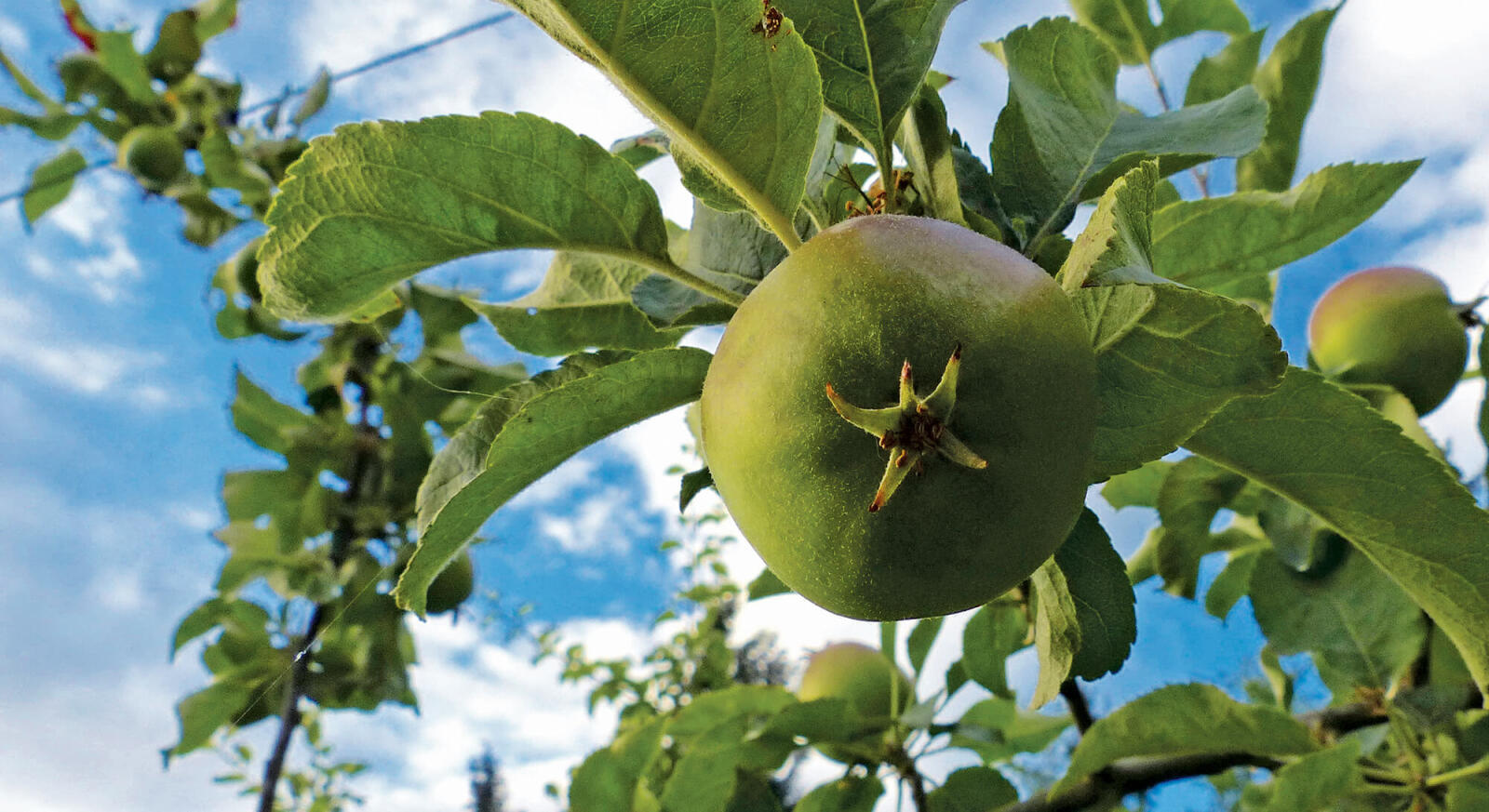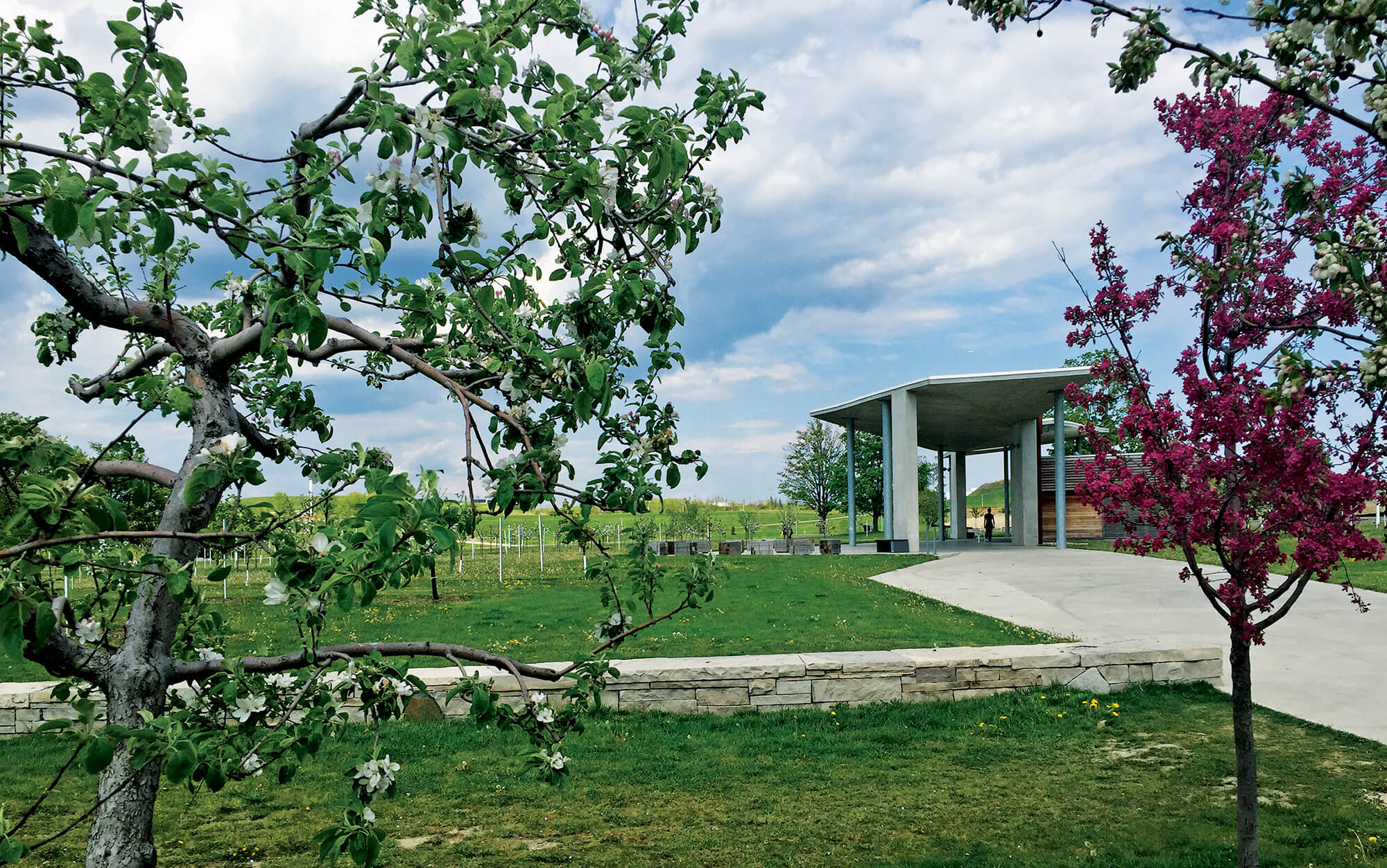January 15, 2018

The easier way to integrate fruit trees into landscapes
If you have been in the landscaping business for a while, you hear it over and over again: clients want a beautiful landscape — and one that’s low maintenance. Over time, you may have found a way to give them exactly what they want.
Now some clients are asking for just one more “little” thing. In an effort to live more sustainably, they want their new, beautiful low-maintenance garden to produce an annual harvest of organic fruit. After all, if you are planting trees, why not plant fruit trees?
You may want to satisfy your client, but most of us in the landscape profession know that fruit trees that are not properly cared for can be messy and caring for them calls for specialized skills. The good news is that with a little research you can give your clients what they want.
In this article, I will explore how to research and source fruit trees that are easier to grow than most of the common “supermarket” varieties. Then direct your client to reliable resources on fruit tree care — or learn those skills yourself, and add fruit tree care to the services you offer.
But there are many cultivars that are easier to grow. Some are available only at specialist fruit tree nurseries; choose a source, download their catalogue and you are ready to start doing research.
For example, McIntosh apples are cross-pollinating trees that need to be planted with another cultivar in order to produce fruit. If you buy two McIntosh apple trees and plant them side-by-side, they won’t produce fruit.
Instead, choose another apple cultivar that flowers at the same time, so cross pollination can take place. For example, plant a McIntosh apple tree not far from a Golden Delicious tree. Search for apple tree pollination charts online to check that your selections will successfully cross-pollinate.
If you are worried about getting it wrong, you can also search your nursery catalogue for a “self-pollinating” tree. Many types of apricot, peach, sour cherry and Asian pear trees are self-pollinating, and will produce a beautiful harvest even if they are the only fruit tree in the landscape.
These cultivars may not be famous, but they taste great! Some examples of disease-resistant apple trees are: Liberty, Freedom, Wolf River, and Sweet Sixteen. When perusing your fruit tree nursery’s catalogue, look for information about disease resistance in the cultivar descriptions.
If you know there is a problem with cedar apple rust in your community, make sure you buy a tree that is resistant to rust; the same goes for fireblight. Or, if you want to hedge your bets, find trees resistant to as many diseases as possible, and recommend them to your client.
 An orchard in Toronto’s Downsview Park. In the foreground is an old, transplanted apple tree, behind is an orchard of over 200 fruit trees.
An orchard in Toronto’s Downsview Park. In the foreground is an old, transplanted apple tree, behind is an orchard of over 200 fruit trees.
If you plant five fruit trees that all produce their harvest in September, your client will have far too much fruit in September, and none at all during the rest of the growing season. Instead, select trees that produce fruit at different times. For example, cherries ripen in July, plums in August, apples in September and pears in October.
If you get your clients started on the right foot, they will be delighted with their new garden and will continue to enjoy it year after year. It will be beautiful. It can be relatively low-maintenance. And in addition, it will also provide your client with an abundance of delicious and nutritious local organic fruit.
Susan Poizner, based in Toronto, teaches homeowners, arborists, master gardeners and landscapers fruit tree care skills online at www.orchardpeople.com.
Now some clients are asking for just one more “little” thing. In an effort to live more sustainably, they want their new, beautiful low-maintenance garden to produce an annual harvest of organic fruit. After all, if you are planting trees, why not plant fruit trees?
You may want to satisfy your client, but most of us in the landscape profession know that fruit trees that are not properly cared for can be messy and caring for them calls for specialized skills. The good news is that with a little research you can give your clients what they want.
In this article, I will explore how to research and source fruit trees that are easier to grow than most of the common “supermarket” varieties. Then direct your client to reliable resources on fruit tree care — or learn those skills yourself, and add fruit tree care to the services you offer.
Source the right fruit tree
Most fruits we find in the supermarket are hard to grow. Almost all of them, like Bartlett pears or Honeycrisp apples, have been bred to thrive with the help of harsh pesticides and fungicides.But there are many cultivars that are easier to grow. Some are available only at specialist fruit tree nurseries; choose a source, download their catalogue and you are ready to start doing research.
Choose a fruit tree that will pollinate successfully
There is nothing worse than planting a fruit tree that never produces fruit. Once you have a list of potential fruit trees that will survive in your climate, your next challenge is to ensure your tree will pollinate successfully. Many types of fruit trees are “cross-pollinating.” That means you need to plant two different (and compatible) cultivars if you want your tree to produce fruit.For example, McIntosh apples are cross-pollinating trees that need to be planted with another cultivar in order to produce fruit. If you buy two McIntosh apple trees and plant them side-by-side, they won’t produce fruit.
Instead, choose another apple cultivar that flowers at the same time, so cross pollination can take place. For example, plant a McIntosh apple tree not far from a Golden Delicious tree. Search for apple tree pollination charts online to check that your selections will successfully cross-pollinate.
If you are worried about getting it wrong, you can also search your nursery catalogue for a “self-pollinating” tree. Many types of apricot, peach, sour cherry and Asian pear trees are self-pollinating, and will produce a beautiful harvest even if they are the only fruit tree in the landscape.
Choose a disease-resistant tree
One of the most important things to consider when choosing a fruit tree is to select one that is resistant to the most common fruit tree diseases we see in our landscapes. Disease-resistant trees are easier to grow for both beginner and advanced organic growers.These cultivars may not be famous, but they taste great! Some examples of disease-resistant apple trees are: Liberty, Freedom, Wolf River, and Sweet Sixteen. When perusing your fruit tree nursery’s catalogue, look for information about disease resistance in the cultivar descriptions.
If you know there is a problem with cedar apple rust in your community, make sure you buy a tree that is resistant to rust; the same goes for fireblight. Or, if you want to hedge your bets, find trees resistant to as many diseases as possible, and recommend them to your client.
 An orchard in Toronto’s Downsview Park. In the foreground is an old, transplanted apple tree, behind is an orchard of over 200 fruit trees.
An orchard in Toronto’s Downsview Park. In the foreground is an old, transplanted apple tree, behind is an orchard of over 200 fruit trees.
Stagger the harvest
Finally, if you are planting more than one tree, consider the harvest times for each cultivar. This will also be included in the cultivar description.If you plant five fruit trees that all produce their harvest in September, your client will have far too much fruit in September, and none at all during the rest of the growing season. Instead, select trees that produce fruit at different times. For example, cherries ripen in July, plums in August, apples in September and pears in October.
Recommend care
Even well chosen, easier-to-grow fruit trees need hands-on care. They need correct annual pruning from the first year of planting. They need annual feeding in the spring and, ideally, monthly monitoring for pests and disease problems. These aren’t hard skills to learn. I teach them online at www.orchardpeople.com/workshops or you can buy a good book to learn the basics.If you get your clients started on the right foot, they will be delighted with their new garden and will continue to enjoy it year after year. It will be beautiful. It can be relatively low-maintenance. And in addition, it will also provide your client with an abundance of delicious and nutritious local organic fruit.
Susan Poizner, based in Toronto, teaches homeowners, arborists, master gardeners and landscapers fruit tree care skills online at www.orchardpeople.com.